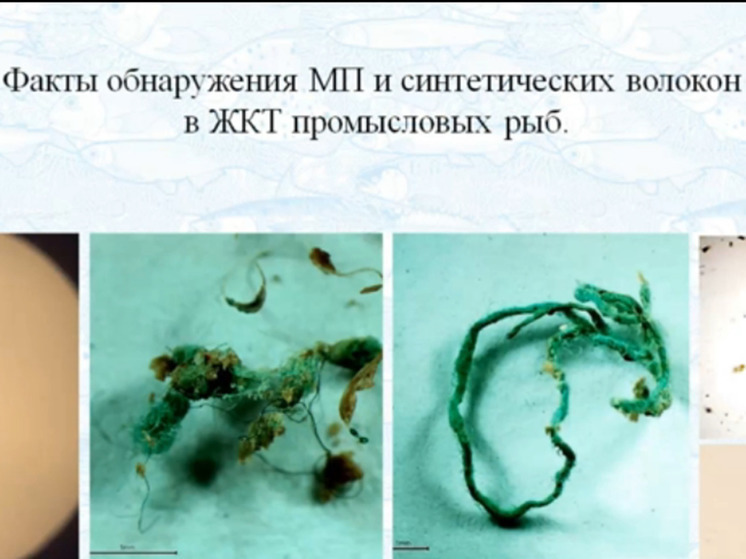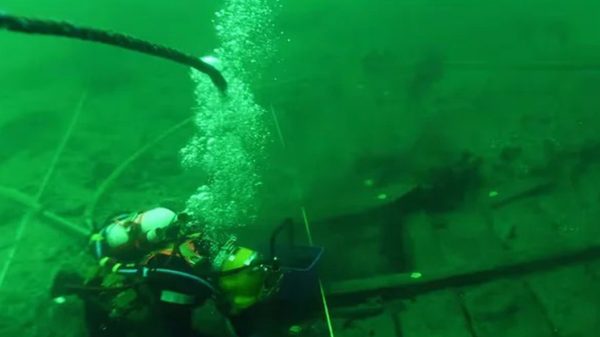Experts emphasized that there is more plastic in nature and food, but it is too early to panic about this
We live in a world of micro and nanoplastics. It is everywhere — from the simple bottled water we drink to vegetables, beer, wine, meat! If in two thousand years archaeologists excavate our cultural layer, they will call it a microplastic civilization. Scientists spoke about how dangerous plastic is for humans on Tuesday at the Federal Research Center for Nutrition and Biotechnology, at a symposium entitled “Microplastics in the environment and food products: analysis of risks to public health.”
 1.MP and synthetic fibers from the gastrointestinal tract of Okhotsk fish seas. 2. Synthetic fibers and MP from the gastrointestinal tract of beaked perch from the Bering Sea. Photo: VNIRO
1.MP and synthetic fibers from the gastrointestinal tract of Okhotsk fish seas. 2. Synthetic fibers and MP from the gastrointestinal tract of beaked perch from the Bering Sea. Photo: VNIRO
Everyone knows the problem of recycling plastic, which over the past 30-40 years has become a real problem threatening the ecology of the planet. But there are also micro- and nanoplastics. These are very small solid polymer particles formed as a result of plastic waste entering the environment and subsequent destruction. The smallest particles of plastic are nanosized — less than 1 micrometer. They penetrate into water, soil, plants and, accordingly, into all products that humans consume. We don’t notice how we regularly “sweeten” our food. microplastics in our food when we eat from plastic dishes, drink from plastic bottles, cut food on plastic boards.
The first speaker at the symposium was the director of the Research Institute of Epidemiology and Microbiology. G.P. Somova, Doctor of Biological Sciences from Vladivostok Mikhail Shchelkanov. He spoke about the largest reservoir of tiny microplastic particles in the ocean, “fraught with a strategic threat.”
– It is customary to divide microplastics into primary and secondary, – says Shchelkanov. – Primary is initially formed by humans in the form of microparticles for use in various technological processes. Well, for example, in cosmetic creams and adhesive bases. So, for example, body scrubs. Despite manufacturers' statements about the use of natural ingredients in them, in the vast majority of cases they use plastic microspheres.
According to the scientist, several million tons of plastic waste enter the world's oceans every year. In 2022 it was 9 million tons, and already in 2023 – 9.5 million tons. Up to 70 percent of this waste is washed into the ocean by rivers that flow through densely populated areas. Record holder – China's Yangtze River, followed by the North American Mississippi, then – rivers of the Hindustan Peninsula, a fairly large group of rivers flowing into the Mediterranean and Black Seas. But such large rivers as our Yenisei and Ob are not included in their number due to the low density of inhabitants inhabiting their banks.
Secondary microplastic, according to Shchelkanov, is formed under the influence of environmental conditions, including mechanical exposure and biological degradation.
– Accumulating in the environment, microparticles of polymers are transmitted through food chains and enter the human body primarily through the gastrointestinal tract. The main route of entry of microplastics into the body – This is the consumption of contaminated food and water, including using plastic and even glass containers. As the results of special studies show, microplastics are found in almost all food products and drinks, including vegetables, fish, seafood, even table salt (!), as well as sugar, honey, milk, drinking water and highly processed drinks such as kvass, wine, beer, – said the scientist. If in a couple of thousand years future archaeologists characterize our modern civilization, they will call it a microplastic civilization, since our cultural layer will be replete with the products of plastic decomposition. Already today, a new shell of the Earth is intensively forming, called the “Plastisphere”.
I wonder how much microplastic is in food?
Today, according to the scientist, we consume it on a regular basis. Thus, 85% of water samples in 59 of the most economically developed countries of the world, including Russia, showed the content of microplastics with an average concentration of 5.5 tenths of particles per liter.
– Microplastic particles were even found in mineral water contained in both plastic and glass bottles – added Mikhail Yurievich. – Moreover, the average number of microplastic particles in mineral water varied from 14 to 6300 particles per liter. Their concentration in glass bottles often exceeded these values, which is actually very strange (according to previously published articles, water in glass containers is one of the few sources of water without significant microplastic impurities).
According to the data cited by Shchelkanov, when microplastics enter the gastrointestinal tract, they can destroy mucous membranes, disrupt the normal composition and functional characteristics of the intestinal microbiome, and contribute to the development of dysbiosis. Microplastics can also be a source of toxic substances. The most famous of them – polychlorinated biphenyls — carcinogens present in paints, varnishes, and chemical additives to pesticides.
In conclusion, the scientist added that the data presented were obtained from a limited number of experimental studies. The scientific community, according to him, needs to conduct a large-scale study of the effect of microplastics on soil, aquatic organisms, and water.
This thesis was confirmed by other scientists who spoke next. For example, a leading researcher at the All-Russian Research Institute of Fisheries and Oceanography, Andrei Pedchenko, spoke about studies of the gastrointestinal tract of salmon fish, in which microplastics were found, but explained that it is still necessary to study marine life for the presence of plastic in their meat.
And the head of the Department of Physics of Polymers and Crystals, Faculty of Physics, Moscow State University. Lomonosov Moscow State University, academician Alexey Khokhlov even said a word in defense of disposable polymer products:
— Everyone says that disposable tableware, films – this is bad. But thanks to disposable polymer products, there are much fewer intestinal infections in the world!
The scientist also noted that, in his opinion, the harm of microplastics on the body is overestimated, modern civilization cannot abandon plastic products, they should not be banned , but think about how to properly dispose of it.
According to Chinese scientists from Guangzhou Medical University and Jinan University, up to 90% of micro- and nanoplastic particles settle after boiling water.


























































Свежие комментарии